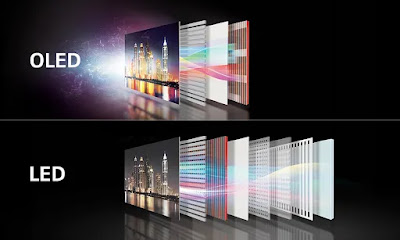Here, in this blog you can get together Full information about LTPO OLED backplane display.
LTPO is a type of OLED display backplane technology. Firstly, LTPO was developed by Apple. Apple uses this technology in the Apple Watch Series 5 in which it scale a refresh rate from 60Hz down to 1Hz. By adopting such tech in smartphone displays could reduce their power consumption and last longer.
LTPO DISPLAY:
➽LTPO stand for Low-Temperature Polycrystalline Oxide.
➽LTPO is a combinations of both LTPS TFTs and Oxide TFTs
➽ LTPO can be used for both OLED and LCD displays.
➽ But this backplane technology is likely to be used in high end OLED displays.
WHY LTPO DISPLAY BACKPLANE TECHNOLOGY?
➽ The main use of LTPO backplane technology is to reduce the power consumption by varying the refresh rate. The term “refresh rate” means that the number of times a display updates or refreshes in a second, measured by frequency in hertz (Hz).
➽ LTPO display is good compared to other display because it dynamically change the refresh rate on the smart screen.
➽ In LTPO, the switching circuits are using LTPS while the driving TFTs will use IGZO (Indium Gallium Zinc Oxide) materials. This could ultimately lead to a power saving of around 5-20% compared to the currently-used LTPS backplanes.
➽ For instance, if I'm scrolling through my home screen, the refresh rate will remain at peak, and the moment I switch to a video which is being streamed at 60FPS like on YouTube, the display will go down to 60FPS.
HISTORY BEHIND LTPO DISPLAY:
➽ In September 2014 ,Apple introduced the world's first device with an LTPO display - the Watch Series 4 and Watch Series 5 . This provide Apple watch series to have an always-on display and all-day battery life, It is due to the refresh rate which can drop to 1 or 2 Hz. While LTPO is an Apple-developed technology ,on the opposite side Samsung has also been performing on similar display technology. Samsung’s called it's display as hybrid-oxide and polycrystalline silicon (HOP). According to report from Korea, Apple has tested BOE's AMOLEDs for next year's iPhone productions, but BOE's OLED production quality isn't good and well for Apple. This leads that in 2021, Samsung Display and LG Display will remain the exclusive OLED suppliers to Apple's phones. In 2021 it is likely that Apple will introduce it's own LTPO displays in addition to screens with a 120Hz refresh rates. Brands like Samsung and OnePlus have worked on their own display tech that is similar to an LTPO backplane.
➽Samsung has developed a technology known as HOP (hybrid-oxide and polycrystalline silicon).HOP combines LTPO tech with oxide TFTs. Samsung applied this tech firstly in the Samsung Galaxy Note 20.But after with the Samsung Galaxy S21, Samsung has created an LTPO panels that can reduce the power consumption of OLED by 16 percent.
➽ OnePlus 9 Pro also had found the right balance between a fast refreshing display that adjusts itself to as less as 1Hz and goes up to 120Hz.The use of this tech extremely reduce screen power consumption by up to 50%.
➽ But, leakers suggest that Apple is planning on adding this tech in the upcoming iPhone. It was already reported that Apple aims to adopt LTPO backplane technology in future iPhone displays.
NOTE:-
Apple has ordered 90M LPTO OLED DISPLAY from Samsung for Iphone 13 series. Normally, Apple produce 75M smartphones and sell it. But, Now They are confident and they have the intrinsic belief that they are going to sell a lot more of these new Iphones than they have past.
LTPO vs LTPS vs IGZO:
Here you can get a clear comparison between LTPS, LTPO, and IGZO.
➽ LTPS backplanes have higher electron mobility and can turn pixels on/off faster. Here transistor size can be reduced and more transistors can now be added within the same space, thus resulting in more pixels or higher resolution. Furthermore with faster mobility, LTPS panels also have higher leakage.
➽ IGZO backplane technology or transistors utilized in backplanes that are often used for IPS LCD displays. IGZO transistors are transparent and thus IGZO backplane displays require less backlight power and consume less power. Electron Mobility of IGZO is as high as LTPS and these displays are more touch-sensitive (we expect the use of IGZO in Samsung Galaxy Note20 Ultra’s display that plays a major role in reducing S Pen latency to 9ms).The uniformity of electron mobility is less than LTPS.
➽ LTPO display combines the technique of both LTPS and IGZO resulting in a more responsive screen that consumers lesser power than conventional LTPS screens. As stated above, in LTPO panels, the switching circuits use LTPS TFTs and also the driving TFTs use IGZO materials.
BENEFITS OF LTPO BACKPLANE TECHNOLOGY:
The smartphone use high power mainly consumed due to its power consuming display component. While the Wi-Fi and Bluetooth technologies do not consume so much power as compared to displays.
The main aim of LTPO is to reduce the massive power consuming factor of the display screen. Earlier said, this could be achieved by having a varying refresh rate. By refresh rate, it means the number of display refreshes in a second while it is measured in frequency (Hz).
LIST OF BEST PHONES AND GADGETS WITH LTPO DISPLAYS:
Smartphones:
FOR REFERECNCES:-







